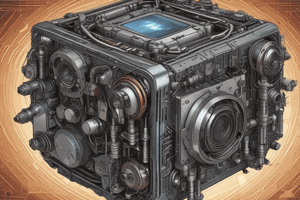Podcast
Questions and Answers
What is the purpose of connecting SCRs in series?
What is the purpose of connecting SCRs in series?
- To enhance switching speed
- To increase current capacity
- To decrease voltage drop
- To achieve high voltage demand (correct)
What does string efficiency measure?
What does string efficiency measure?
- The total current rating of SCRs
- The degree of utilization of SCRs in a string (correct)
- The switching time of SCRs
- The maximum voltage each SCR can handle
What is the derating factor (DRF) in relation to string efficiency?
What is the derating factor (DRF) in relation to string efficiency?
- String efficiency plus 1
- Voltage rating divided by string efficiency
- 1 minus string efficiency (correct)
- String efficiency squared
Why is voltage sharing among SCRs in series not always equal?
Why is voltage sharing among SCRs in series not always equal?
How can a uniform voltage distribution across series-connected SCRs be achieved?
How can a uniform voltage distribution across series-connected SCRs be achieved?
What happens when two SCRs with unequal dynamic characteristics are gated simultaneously?
What happens when two SCRs with unequal dynamic characteristics are gated simultaneously?
What determines the voltage distribution across SCRs in series during turn ON and turn OFF processes?
What determines the voltage distribution across SCRs in series during turn ON and turn OFF processes?
Which component is essential for limiting the dv/dt across an SCR during forward blocking state?
Which component is essential for limiting the dv/dt across an SCR during forward blocking state?
What role does the shunt capacitance play in a series-connected SCR string under transient conditions?
What role does the shunt capacitance play in a series-connected SCR string under transient conditions?
In parallel operation of SCRs, what is the primary concern for the firing circuit?
In parallel operation of SCRs, what is the primary concern for the firing circuit?
Which component is involved in damping out high frequency oscillations that may arise in series-connected SCRs?
Which component is involved in damping out high frequency oscillations that may arise in series-connected SCRs?
Why is the choice of capacitance critical during the turn OFF process of series connected SCRs?
Why is the choice of capacitance critical during the turn OFF process of series connected SCRs?
What is one key attribute of firing circuits essential for both series and parallel operations in SCRs?
What is one key attribute of firing circuits essential for both series and parallel operations in SCRs?
What is the main purpose of equalization in battery packs?
What is the main purpose of equalization in battery packs?
Which feature is unique to dynamic equalizing circuits compared to static equalizing circuits?
Which feature is unique to dynamic equalizing circuits compared to static equalizing circuits?
What role do current transformers play in equalization of SCRs?
What role do current transformers play in equalization of SCRs?
What is a disadvantage of using resistors for current equalization in SCRs?
What is a disadvantage of using resistors for current equalization in SCRs?
Which method is used in dynamic equalizing circuits to correct imbalances?
Which method is used in dynamic equalizing circuits to correct imbalances?
What is the function of snubber circuits in parallel-connected SCRs?
What is the function of snubber circuits in parallel-connected SCRs?
Which of the following is NOT a feature of static equalizing circuits?
Which of the following is NOT a feature of static equalizing circuits?
How do microcontroller-based equalization systems enhance balancing?
How do microcontroller-based equalization systems enhance balancing?
Which term describes the efficiency of a string of solar panels?
Which term describes the efficiency of a string of solar panels?
What can significantly reduce the overall performance of a solar PV string?
What can significantly reduce the overall performance of a solar PV string?
Which factor can lead to a reduction in string efficiency due to variations in current-voltage curves?
Which factor can lead to a reduction in string efficiency due to variations in current-voltage curves?
How is string efficiency typically expressed?
How is string efficiency typically expressed?
Which of the following methods can improve string efficiency in a solar PV system?
Which of the following methods can improve string efficiency in a solar PV system?
What happens to efficiency when temperature increases in solar panels?
What happens to efficiency when temperature increases in solar panels?
What is the primary purpose of de-rating factors in engineering?
What is the primary purpose of de-rating factors in engineering?
Which type of de-rating factor addresses issues with temperature effects on components?
Which type of de-rating factor addresses issues with temperature effects on components?
What is a common effect of operating electronic components at elevated temperatures?
What is a common effect of operating electronic components at elevated temperatures?
Which of the following is NOT a factor that can lead to voltage de-rating?
Which of the following is NOT a factor that can lead to voltage de-rating?
What is the impact of altitude on certain components in engineering applications?
What is the impact of altitude on certain components in engineering applications?
What is the primary purpose of a snubber circuit in relation to SCRs?
What is the primary purpose of a snubber circuit in relation to SCRs?
What characteristic does an external di/dt limiting network provide to SCR protection?
What characteristic does an external di/dt limiting network provide to SCR protection?
What is a critical ideal characteristic of an over-voltage protection (OVP) circuit?
What is a critical ideal characteristic of an over-voltage protection (OVP) circuit?
How do RC snubbers protect SCRs during turn-off?
How do RC snubbers protect SCRs during turn-off?
Which of the following is a feature of a crowbar circuit used for over-voltage protection?
Which of the following is a feature of a crowbar circuit used for over-voltage protection?
What is the function of gate resistance in protecting SCRs against dv/dt?
What is the function of gate resistance in protecting SCRs against dv/dt?
What impact can an over-voltage condition have on electronic components?
What impact can an over-voltage condition have on electronic components?
Which protective method inherently offers improved dv/dt immunity during turn-off?
Which protective method inherently offers improved dv/dt immunity during turn-off?
Flashcards
Series Connection of SCRs
Series Connection of SCRs
Multiple SCRs connected in a series arrangement to handle higher voltage demands.
String Efficiency
String Efficiency
Measure of how effectively SCRs in a string utilize the total voltage.
Derating Factor (DRF)
Derating Factor (DRF)
Difference between 1 and string efficiency, used to adjust SCR usage for safety considerations.
Unequal Voltage Distribution (SCRs)
Unequal Voltage Distribution (SCRs)
Signup and view all the flashcards
State Equalizing Circuit
State Equalizing Circuit
Signup and view all the flashcards
Unequal Dynamic Characteristics (SCRs)
Unequal Dynamic Characteristics (SCRs)
Signup and view all the flashcards
SCR Series Connection
SCR Series Connection
Signup and view all the flashcards
Reverse Recovery
Reverse Recovery
Signup and view all the flashcards
Dynamic Equalizing Circuit
Dynamic Equalizing Circuit
Signup and view all the flashcards
Firing Circuit
Firing Circuit
Signup and view all the flashcards
Series Operation (Firing)
Series Operation (Firing)
Signup and view all the flashcards
Parallel Operation (Firing)
Parallel Operation (Firing)
Signup and view all the flashcards
Static Equalizing Circuit
Static Equalizing Circuit
Signup and view all the flashcards
Static Equalization
Static Equalization
Signup and view all the flashcards
Dynamic Equalization
Dynamic Equalization
Signup and view all the flashcards
Parallel SCR Current Balancing
Parallel SCR Current Balancing
Signup and view all the flashcards
Current Transformer (SCR)
Current Transformer (SCR)
Signup and view all the flashcards
Feedback Control (SCR)
Feedback Control (SCR)
Signup and view all the flashcards
Resistive Divider Equalization
Resistive Divider Equalization
Signup and view all the flashcards
Zener Diode Shunt Equalization
Zener Diode Shunt Equalization
Signup and view all the flashcards
String Efficiency (PV)
String Efficiency (PV)
Signup and view all the flashcards
Passive equalization network
Passive equalization network
Signup and view all the flashcards
Solar String Shading
Solar String Shading
Signup and view all the flashcards
Panel Mismatch
Panel Mismatch
Signup and view all the flashcards
Temperature Variation
Temperature Variation
Signup and view all the flashcards
Inverter Efficiency
Inverter Efficiency
Signup and view all the flashcards
String Efficiency Calculation
String Efficiency Calculation
Signup and view all the flashcards
Derating Factors (Temperature)
Derating Factors (Temperature)
Signup and view all the flashcards
Derating Factors (Voltage)
Derating Factors (Voltage)
Signup and view all the flashcards
Derating Factors (Current)
Derating Factors (Current)
Signup and view all the flashcards
Panel Selection (Efficiency)
Panel Selection (Efficiency)
Signup and view all the flashcards
String Design (Efficiency)
String Design (Efficiency)
Signup and view all the flashcards
Snubber Circuits
Snubber Circuits
Signup and view all the flashcards
di/dt
di/dt
Signup and view all the flashcards
dv/dt
dv/dt
Signup and view all the flashcards
Over-Voltage Protection
Over-Voltage Protection
Signup and view all the flashcards
Crowbar circuit
Crowbar circuit
Signup and view all the flashcards
RC snubbers
RC snubbers
Signup and view all the flashcards
Gate-Triggering Circuits
Gate-Triggering Circuits
Signup and view all the flashcards
External di/dt Limiting Networks
External di/dt Limiting Networks
Signup and view all the flashcards





